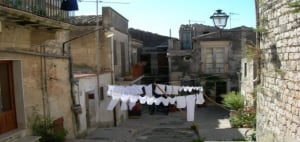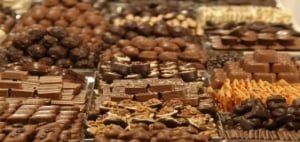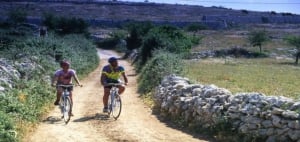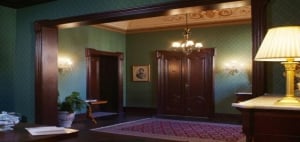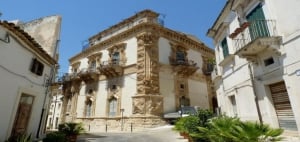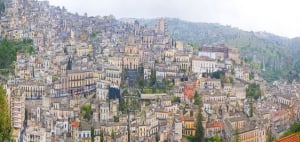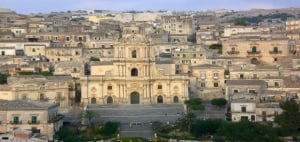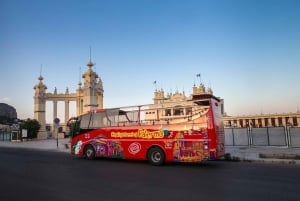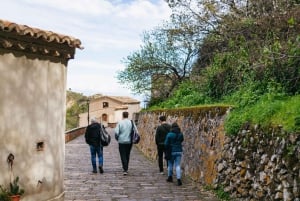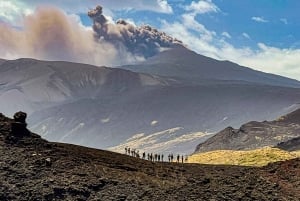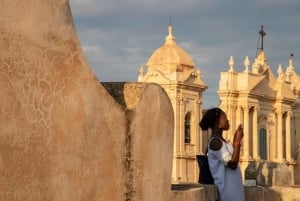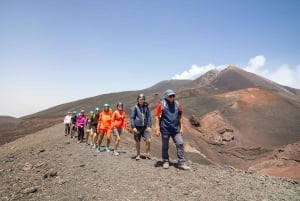Modica
Modica is another stony jewel of the “Val di Noto” – UNESCO World Heritage Site since 2002. The town was reconstructed almost entirely in Sicilian Baroque architecture after the earthquake in 1693, like Catania, Ragusa, Noto, Palazzolo Acreide and many other cities of the Val di Noto. Much of this was in the form of churches, Modica is also called the “City of Hundred Bells and Hundred Churches”, and indeed you won’t be hard pressed to hear the chiming of bells while you’re there.
Modica is also famous in Italy for its sweets and in particular for chocolate. One of the key features of the city is the main road, Corso Umberto I., which historically was a river. Well, whatever your motivation is to visit Modica, wandering the buildings with their Baroque curlicues (Baedeker named Modica the “Baroque Pomp in the Canyon” – we love this name...), and visiting the magnificent churches is an excellent way to build up a good appetite for the unique local cuisine.
Modica is divided into two parts: the upper town Modica Alta and the lower town Modica Bassa. During the last century the city has developed new suburbs which are often referred to as “Modern Modica". Today modern and old quarters of the city are joined by the Guerrieri-Bridge which is with 300 metres height one of Europe’s higher bridges.
Best time to visit Modica is from mid September to end of May. The walk up to Modica Alta can be quite exhausting, so make sure to wear really comfy shoes.
Things to do and see in Modica
Well, you don't have to worry. We won't bother you with a list all 100 churches of Modica.....
A Baroque highlight of Sicily is the St. Peter’s Cathedral in Modica Bassa, featuring an elegant facade, a typical Sicilian bell tower of 49 m height, and a staircase lined with statues of the apostles. It houses paintings of Gagini.
One of the finest examples of a Sicilian Baroque church is definitely the Cathedral San Giorgio in Modica Alta, with its 18th century facade, an elaborate belfry and a very rich interior with gildings and stuccoes. You can reach it by a monumental stairway of 250 steps, which is flanked by gardens, boasting stunning views over the town.
Near San Pietro and next to the info-point, the Museo Civico F.L. Belgiorno houses a collection of art objects and archaeological finds of the province of Ragusa.
Just follow the signs "Casa Natale di S. Quasimodo" from the Cathedral San Pietro to the birthplace of Modica’s most famous son, the poet Salvatore Quasimodo. No, he is not related to the Hunchback of Notre Dame in the novel written by Victor Hugo, and there is also no Esmeralda! Please inform your children that there are nowhere Disney cartoons…..S. Quasimodo received the Nobel Prize for Literature in 1959 and you can visit to the place he was born in Via Posterla 84, a small two room apartment. He worked as a professor for literature at the University of Milan and translated Shakespeare and Neruda into Italian, but mainly he was a poet and writer. The city of Modica bought his Milan study to expose it here.
Museo Etnogràfico Guastella
In the south of Modica the Palazzo dei Mercedari houses a remarkable ethnical museum - numerous exhibits tell us a lot about the rural and municipal life of the towns’ past.
Palazzo de Leva & Castello dei Conti
In Modica Bassa you should also pay a visit to the Palazzo De Leva, town mansion of the noble family De Leva for centuries. Today it is used for art exhibitions and cultural events. Hidden in its small garden is a 14th century church portal which is framed by a decorative Norman zigzag-motive. Worth a visit are also the ruins of the "Castle of the Counts" which lie on a high rock spur.
Modica off the beaten track - Chiesa Rupestre di San Nicolò Inferiore
From San Pietro follow the signs “Casa Natale di Quasimodo” and turn to the right before the stairs. You are going to see an archaeological sensation – an ancient cave church. It was used as a stockroom when a little boy saw accidentally some faces under the roughcast in the year 1987. Just as accidentally he told an adult, who just as accidentally was the director of the ethnical museum. This church had probably been forgotten after the big earthquake in 1693. Since 1997 interested visitors are welcome to have a look at San Nicolò Inferiore with its unusual history. The oldest frescoes are Byzantine and date back to the 12th century. In the 14th century the church was Latinized and the original frescoes were painted over – Latin writing and the cross of the Archangel George are clearly to be seen. On the right hand side a wall painting of 1594 (when the Spaniards were ruling in Sicily) shows the Spanish national saint Jacob (San Jacobo or San Jaime). The explorations of the church are still going on, and we are curious what the archaeologists will find next.
Scicli
Only ten kilometres from Modica lies the small town of Scicli. It is easily reachable by car and train. Scicli also was destroyed by the disastrous earthquake in 1693, rebuilt in Sicilian Baroque and is listed as UNESCO World Heritage Site. It features several beautiful churches and numerous Baroque palaces, in particular at the magnificent street Via Mormino Penna. But the absolute highlight of this little town are the balconies of the Palazzo Benventano, which are decorated with really peculiar figures. Second to Sir Anthony Blunt this town mansion is the most beautiful palazzo in the whole of Sicily.
Local Tip: Restaurant Pizzeria La Grotta, Chef Angelo uses exclusively fresh ingredients for his typical local dishes.
Chocolate and Sweets Tasting in Modia
Apart from visits to the churches and museums: an absolute MUST is a tasting of Modica’s chocolate which is made according to ancient Aztec recipes, brought to Sicily by the Spaniards. Be warned that this chocolate is a far spicier kind that you are used to. It is not creamy, milky or sweet. The Aztecs mixed cinnamon, coffee, pepper, vanilla and citrus fruits into the cocoa. This way of producing chocolate was never industrialized, and the best place to get an overview is at the Antica Dolceria Bonajuto on Corso Emanuele. We are sure that good old Francesco Bonajuto would be very proud and happy that his chocolate dreams are still coming true after more than 130 years in the same place he founded his little chocolate factory. You can taste all sorts of choco-specialties, and even if you don’t get accustomed to the unusual taste they still make wonderful and unique souvenirs - lovingly packed in old fashioned tin boxes and paper.
Tasty and other souvenirs at our Shopping page
For those who are tots but do not like chocolate: Modica is the “Capital of Sweets” – there are pastry shops and confectionaries everywhere, offering all sorts of cakes and sweets. In Vico de Naro 9 you will find the “Laboratorio Dolciario Artigianale Don Giuseppe Puglisi” where only fair trade ingredients are used.
Biking in and around Modica
An excellent way to lose the extra pounds you inevitably put on when you are staying more than some hours in Modica is by biking. The area between Syracuse, Noto, and Ragusa offers great biking routes.
Restaurants in Modica
Modica's culinary tradition features sweet and savoury dishes, which are influenced by the former Arab and Spanish occupants. Try a pastry roll with cabbage “scaccie modicana” or the delicious creamy almond dessert “biancomangiare”. You can choose between several excellent restaurants and trattorias, two of them are “crowned” by Michelin stars.
Please see more at our Restaurants page
Accommodation in Modica
Modica offers accommodations for every taste and every need: from simple guest houses, B&Bs and business hotels to charming small hotels located in historical palazzos. You will find most of the accommodation in Modica Bassa, but our favourite is in the upper town - the elegant hotel-dwarf Palazzo Failla with only ten rooms, all furnished with antiques, featuring high ceilings painted with frescoes (not to speak of the hotel's Michelin-starred restaurant)
See more at Accommodation
Events in Modica
One big event in Modica is the “Chocobarocco” festival, dedicated to the art of producing chocolate (dates can differ)
In February Modica is celebrating the festival “Sapori e Saperi di Piazza” - the art of street food.
If you are in the area around Easter don't miss the Vasa Vasa (Sicilian for kiss kiss). Maybe you will be a bit confused, because despite the title it is a rather solemn affair. The highlight at the end of the festival is when all bells of the hundred churches chime and firecrackers explode.
In mid June the ALTArte Festival takes place: for two days puppeteers and street artists populate the centre - there are small historical markets, handicraft and art exhibitions
More events in Sicily are here
Modica with children
If your offspring starts to complain about the steady climbing up and down - there is a sufficient number of pastry and chocolate shops in town. We think a little corruption is ok!
A visit to the Museo Etnografico Guastella might also be interesting for little travellers, and for sure they will like to explore the ancient cave church "Rupestre di San Nicolò Inferiore", in particular when you tell them that a little boy discovered it.
And - if you are staying in Syracuse: from June to October the "Treno del Barocco" connects both cities. Your children will love the ride on this old steam engine train.
More ideas for your kiddies' holiday entertainment find here
How to get to Modica
By airplane
Nearest airport is Comiso (34 km), which is mainly served by low-cost airlines such as Ryanair.
By car
From Trapani, Palermo, and Enna follow A 19. From Messina and Taormina take the A 18 to Catania, then follow SS 194 and SS 514. From Agrigento SS 115.
By bus
Frequent connections by AST, SITA and SAIS Linee to Ragusa, Pozzallo, Noto, Avola and Syracuse, 4-7 times daily to Marina di Modica and 2 times daily to Gela. Tickets available at the bar “Barycentro” opposite the bus stop.
By train
Not recommended, even if there are good connections to Noto, Syracuse and Ragusa – the train station is located 1,5 km from the centre. But: from June to October the old steam engine train “Treno del Barocco” connects Syracuse to Ragusa – with stops in all important Baroque cities on the way (great fun also for children).


